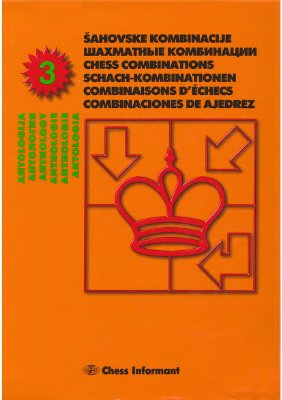Sahovski informator, Beograd, 2005 г. - 577 с. ISBN:
86-7297-053-5
Chess combination is a forced variation with a sacrifice which leads to a positive result.
The third edition of the Anthology of Chess Combinations features several major changes introduced by the Chess Informant Editorial Board. The main one being that it has been divided into two main parts: educative and practical examples.
As a foundation for the first part, the previous edition of the Anthology has been used with our original classification keys pertaining to fundamental tactical motifs. All the material inherited from the previous edition underwent rigorous re-examination by critically-minded experts from the Editorial Board armed with top-level computer engines to ensure the high-quality of the examples.
The second part has been produced to incorporate the elements of a workbook with some of the more recent examples divided into three groups to maintain a clear-cut structure. Our editors also opted to omit a number of old examples for newer, more challenging brain teasers. Each group has three levels of difficulty without any classification keys, thereby prohibiting the prospective solver from benefiting from any hints. However, index of the themes is made available at the end of each level.
1.Warm-up.
2.Examples of intermediate difficulty.
3.Challenging examples.
The big names are included, of course, but even more interesting are their annotations to the games, as they produce an excellent testimony to the depth of some extraordinary ideas that could otherwise have been left unnoticed. We hope that the third edition of the Anthology of Chess Combinations will help readers develop a greater appreciation for the art of combinative chess and a fundamental understanding of how it can be achieved.
Sign following the black player's family name indicates that the displayed position stems from an important line from the game analysis, and that it did not occur as a result of the game's original move sequence.
Chess combination is a forced variation with a sacrifice which leads to a positive result.
The third edition of the Anthology of Chess Combinations features several major changes introduced by the Chess Informant Editorial Board. The main one being that it has been divided into two main parts: educative and practical examples.
As a foundation for the first part, the previous edition of the Anthology has been used with our original classification keys pertaining to fundamental tactical motifs. All the material inherited from the previous edition underwent rigorous re-examination by critically-minded experts from the Editorial Board armed with top-level computer engines to ensure the high-quality of the examples.
The second part has been produced to incorporate the elements of a workbook with some of the more recent examples divided into three groups to maintain a clear-cut structure. Our editors also opted to omit a number of old examples for newer, more challenging brain teasers. Each group has three levels of difficulty without any classification keys, thereby prohibiting the prospective solver from benefiting from any hints. However, index of the themes is made available at the end of each level.
1.Warm-up.
2.Examples of intermediate difficulty.
3.Challenging examples.
The big names are included, of course, but even more interesting are their annotations to the games, as they produce an excellent testimony to the depth of some extraordinary ideas that could otherwise have been left unnoticed. We hope that the third edition of the Anthology of Chess Combinations will help readers develop a greater appreciation for the art of combinative chess and a fundamental understanding of how it can be achieved.
Sign following the black player's family name indicates that the displayed position stems from an important line from the game analysis, and that it did not occur as a result of the game's original move sequence.

